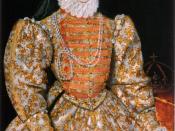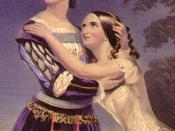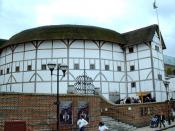Shakespeare and his Theater
Compared to the technical theaters of today, the London
public theaters in the time of Queen Elizabeth I seem to be
terribly limited. The plays had to be performed during daylight
hours only and the stage scenery had to be kept very simple with
just a table, a chair, a throne, and maybe a tree to symbolize a
forest. Many say that these limitations were in a sense
advantages. What the theater today can show for us
realistically, with massive scenery and electric lighting,
Elizabethan playgoers had to imagine. This made the playwright
have to write in a vivid language so the audience could
understand the play. Not having a lighting technician to work
the control panels, Shakespeare had to indicate wether it was
dawn or nightfall by using a speech rich in metaphors and
descriptive details. Shakespeare's theater was far from being
bare, the playwright did have some valuable technical sources
that he used to the best of his ability.
The costumes the actors
wore were made to be very elaborate. Many of the costumes
conveyed recognizable meanings for the audience such as a rich
aristocrat wearing silk clothes with many ruffles. Many times
there were musical accompaniments and sound effects such as
gunpowder explosions and the beating of a pan to simulate
thunder.
The stage itself was also remarkably versatile. Behind it
were doors for exits and entrances and a curtained booth or
alcove useful for actors to hide inside. Above the stage was a
higher acting area which symbolized a porch or balcony. This was
useful in the story of Romeo and Juliet, when Romeo stood below
Juliet and told her how he loved her. In the stage floor was a
trap door which was said to lead to 'hell' or a cellar,


